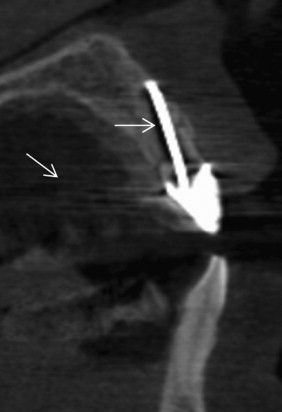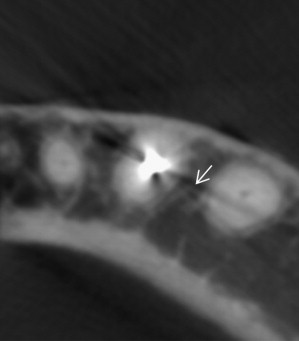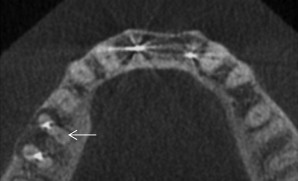Artifacts in radiographic imaging are discrepancies between the reconstructed visual image and the content of the subject. In radiographic imaging, this means the grayscale values in the image do not accurately reflect the attenuation values of the subject. Structures may also appear that do not exist in the subject. Whatever the source or appearance of image artifacts, their presence degrades the accuracy of the image in relation to the true characteristics of the subject. One should therefore be aware of the presence of artifacts and be familiar with their characteristic appearances in order to enhance the extraction of diagnostic information.
Key points
- •
Artifacts in radiographic imaging are discrepancies between the reconstructed visual image and the actual content of the subject being studied.
- •
In radiographic imaging, the discrepancies mean the grayscale values in the image do not accurately reflect the attenuation values of the subject.
- •
Structures may also appear that do not actually exist in the subject. Whatever the source or appearance of image artifacts, their presence degrades the accuracy of the image in relation to the true characteristics of the subject.
- •
It is beneficial to be aware of the presence of artifacts and be familiar with their characteristic appearances in order to enhance the extraction of diagnostic information from cone beam images.
Image artifacts commonly seen in cone beam imaging
Artifacts in radiographic imaging are discrepancies between the reconstructed visual image and the actual content of the subject being studied. In radiographic imaging, this means the grayscale values in the image do not accurately reflect the attenuation values of the subject. Additionally, structures may appear within images that do not actually exist in the subject. Such structures can occur because of patient motion, the image capture and reconstruction process, or malfunctions of the imaging system.
Artifacts that are inherent in the image capture and reconstruction processes involved in cone beam imaging can often be reduced by the use of image-modifying algorithms or by altering the image capture process. Whatever the source or appearance of image artifacts, their presence degrades the accuracy of the image in relation to the true characteristics of the subject. It is therefore beneficial to be aware of the presence of artifacts and be familiar with their characteristic appearances in order to enhance the extraction of diagnostic information from cone beam images.
Radiographic imaging is all about the attenuation of the x-ray beam as it passes through the subject of interest. The x-ray photons interact with the atoms within the subject in a variety of ways and can be removed or diverted from the beam’s path before it exits the subject. Such interactions reduce the number of x-ray photons that strike the image detector used to generate the radiographic image. Metal restorations are composed of materials with high atomic numbers that attenuate the x-ray beam more than materials with low atomic numbers. Bone is composed of materials with moderately high atomic numbers, and therefore it attenuates the beam more than soft tissues.
The most common and annoying artifacts seen in cone beam images are white and dark streaks or light flares originating from dense structures within the image. Such artifacts can originate from multiple sources and have similar appearances. They often overlie areas of diagnostic importance within the image and therefore present image interpretation challenges. It is important to keep in mind that the artifacts seen in cone beam imaging are often related to the geometric process of the x-ray tube head and detector rotating about the subject used to capture the multiple basis images from which 3-dimensional volumes are reconstructed.
Image artifacts commonly seen in cone beam imaging
Artifacts in radiographic imaging are discrepancies between the reconstructed visual image and the actual content of the subject being studied. In radiographic imaging, this means the grayscale values in the image do not accurately reflect the attenuation values of the subject. Additionally, structures may appear within images that do not actually exist in the subject. Such structures can occur because of patient motion, the image capture and reconstruction process, or malfunctions of the imaging system.
Artifacts that are inherent in the image capture and reconstruction processes involved in cone beam imaging can often be reduced by the use of image-modifying algorithms or by altering the image capture process. Whatever the source or appearance of image artifacts, their presence degrades the accuracy of the image in relation to the true characteristics of the subject. It is therefore beneficial to be aware of the presence of artifacts and be familiar with their characteristic appearances in order to enhance the extraction of diagnostic information from cone beam images.
Radiographic imaging is all about the attenuation of the x-ray beam as it passes through the subject of interest. The x-ray photons interact with the atoms within the subject in a variety of ways and can be removed or diverted from the beam’s path before it exits the subject. Such interactions reduce the number of x-ray photons that strike the image detector used to generate the radiographic image. Metal restorations are composed of materials with high atomic numbers that attenuate the x-ray beam more than materials with low atomic numbers. Bone is composed of materials with moderately high atomic numbers, and therefore it attenuates the beam more than soft tissues.
The most common and annoying artifacts seen in cone beam images are white and dark streaks or light flares originating from dense structures within the image. Such artifacts can originate from multiple sources and have similar appearances. They often overlie areas of diagnostic importance within the image and therefore present image interpretation challenges. It is important to keep in mind that the artifacts seen in cone beam imaging are often related to the geometric process of the x-ray tube head and detector rotating about the subject used to capture the multiple basis images from which 3-dimensional volumes are reconstructed.
Beam hardening artifact
Among the most obvious image artifacts are dark bands caused by a process known as beam hardening. The x-ray beam used in cone beam imaging is termed polychromatic. This means the x-ray beam is not composed of x-ray photons of a single energy level. Instead the beam is made up of x-ray photons of many different energy levels, the maximum energy level being equal to the kVp setting selected on the cone beam unit. As the primary beam passes through the subject, the lower energy x-ray photons are more likely to interact with the subject, especially with denser objects such as bone or metal restorations, and they are attenuated or removed from the x-ray beam. The portion of the x-ray beam that exits from the subject and strikes the detector is therefore composed of a greater percentage of high-energy x-ray photons than the beam originating at the tube head.
For the sake of simplicity and to provide reduced cost with faster image reconstruction times, the mathematical algorithm that processes the information from the detector and reconstructs the cone beam image assumes the primary x-ray beam exiting the tube head is monochromatic, (ie, composed of x-ray photons of a single energy level). This discrepancy between the assumed and true photon energy spectrum of the initial x-ray beam causes the algorithm to misinterpret the amount of attenuation experienced by the beam as it passed through the subject, especially the denser objects mentioned above. The algorithm thinks little, if any, attenuation of the primary beam occurred and it assigns incorrectly low gray scale values for the areas within the subject. This under valuation combined with the back projection mathematical process to construct the image volume produces the characteristic dark areas and streaks seen in cone beam images. These artifacts may project over and mask underlying structures, or they may provide false information regarding the density and morphology of those areas within the subject ( Figs. 1–3 ).



Metal artifact
White streaks, often referred to as star effect or metallic artifact, can also be seen in association with metallic structures such as crowns, surface restorations, implants, and surgical plates or screws. This artifact results as the algorithm attempts to reconstruct an object of high atomic number, which greatly attenuates the x-ray beam, into the 3-dimensional image volume from the information contained in the large number of 2-dimensional basis images generated by the rotational geometry of the tube head and detector around the subject.
As with beam hardening artifacts, metal artifacts can mask or misrepresent the character of structures within the image that are located adjacent highly attenuating materials and can project across the image field of view to cause inaccurate grayscale values for areas not immediately adjacent the highly attenuating material. Several types of mental artifact reduction software have been developed in an attempt to eliminate or reduce the effects of mental artifact within the image volume. Most of these software programs evaluate the grayscale values of the voxels just outside the areas of the artifacts and postulate substitute grayscale values to be assigned to the voxels within the affected regions. Although such processes produce a more aesthetic image, the information substituted for the areas that appear as artifact are not true representations of the attenuation values for the related areas in the subject but are essentially best guesses. The masking of areas beyond the metal object can be reduced by placing a cotton roll between the anterior teeth and raising or lowering the patient’s chin, so the artifact streaks are not projected over the entire arch as they are when the occlusal plane is parallel to the floor (see Fig. 1 ; Figs. 4–6 ).





